| Listing 1 - 10 of 275 | << page >> |
Sort by
|
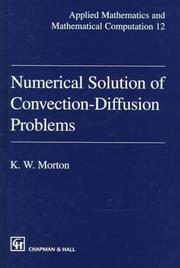
ISBN: 0412564408 Year: 1998 Publisher: London Chapman and Hall
Abstract | Keywords | Export | Availability | Bookmark
 Loading...
Loading...Choose an application
- Reference Manager
- EndNote
- RefWorks (Direct export to RefWorks)
519.6 --- 681.3 *G18 --- 681.3 *G18 Partial differential equations: difference methods elliptic equations finite element methods hyperbolic equations method of lines parabolic equations (Numerical analysis) --- Partial differential equations: difference methods elliptic equations finite element methods hyperbolic equations method of lines parabolic equations (Numerical analysis) --- 519.6 Computational mathematics. Numerical analysis. Computer programming --- Computational mathematics. Numerical analysis. Computer programming --- 681.3 *G18 Partial differential equations: difference methods; elliptic equations; finite element methods; hyperbolic equations; method of lines; parabolic equations (Numerical analysis) --- Partial differential equations: difference methods; elliptic equations; finite element methods; hyperbolic equations; method of lines; parabolic equations (Numerical analysis) --- Numerical solutions of differential equations --- Partial differential equations
Book
ISBN: 3540089675 9783540089674 Year: 1978 Publisher: Berlin Springer
Abstract | Keywords | Export | Availability | Bookmark
 Loading...
Loading...Choose an application
- Reference Manager
- EndNote
- RefWorks (Direct export to RefWorks)
Numerical solutions of differential equations --- Partial differential equations --- 681.3 *G18 --- Partial differential equations: difference methods; elliptic equations; finite element methods; hyperbolic equations; method of lines; parabolic equations (Numerical analysis) --- 681.3 *G18 Partial differential equations: difference methods; elliptic equations; finite element methods; hyperbolic equations; method of lines; parabolic equations (Numerical analysis)
Book
ISBN: 9061964393 Year: 1993 Publisher: Amsterdam Centrum voor Wiskunde en Informatica
Abstract | Keywords | Export | Availability | Bookmark
 Loading...
Loading...Choose an application
- Reference Manager
- EndNote
- RefWorks (Direct export to RefWorks)
519.6 --- 681.3 *G18 --- Computational mathematics. Numerical analysis. Computer programming --- Partial differential equations: difference methods; elliptic equations; finite element methods; hyperbolic equations; method of lines; parabolic equations (Numerical analysis) --- 681.3 *G18 Partial differential equations: difference methods; elliptic equations; finite element methods; hyperbolic equations; method of lines; parabolic equations (Numerical analysis) --- 519.6 Computational mathematics. Numerical analysis. Computer programming
Dissertation
ISBN: 9056826964 Year: 2006 Publisher: Leuven Katholieke Universiteit Leuven
Abstract | Keywords | Export | Availability | Bookmark
 Loading...
Loading...Choose an application
- Reference Manager
- EndNote
- RefWorks (Direct export to RefWorks)
Dit proefschrift beschrijft de ontwikkeling van golfgebaseerde modelleringstechnieken voor het analyseren van stationaire vibro-akoestische problemen. Vaak worden klassieke elementgebaseerde methoden, zoals de eindige-elementenmethode (EEM) en de randelementenmethode (REM), toegepast voor de analyse van dit type van problemen. De toepasbaarheid van de elementgebaseerde methoden is echter beperkt tot het laagfrequente gebied. De golfgebaseerde methode (GBM) is een alternatieve methode die gebaseerd is op een indirecte Trefftz benadering. De GBM is rekenkundig zeer efficiënt, waardoor de methode ook toepasbaar is voor het analyseren van problemen bij hogere frequenties. Dit proefschrift rapporteert over de ontwikkeling van een uitbreiding van de GBM voor het behandelen van akoestische problemen bestaande uit meerdere subdomeinen en voor het analyseren van problemen in oneindige fluïda. De efficiëntie van de GBM is het meest uitgesproken voor problemen met een bescheiden geometrische complexiteit. Een hybride eindige-elementen-golfgebaseerde methode combineert de sterke punten van de twee technieken, namelijk de hoge rekenkundige efficiëntie van de GBM en de toepasbaarheid van de EEM voor problemen met een willekeurige geometrische complexiteit. Numerieke validatievoorbeelden tonen het verhoogde prestatievermogen aan van zowel de uitgebreide GBM voor problemen met een bescheiden geometrische complexiteit, als van de hybride methode voor levensechte ingenieurstoepassingen. This dissertation considers the development of wave based prediction methods for the analysis of steady-state vibro-acoustic problems. Conventional element based prediction methods, such as the finite element method (FEM), are commonly used, but are restricted to low-frequency applications. The wave based method (WBM) is an alternative deterministic technique which is based on the indirect Trefftz approach. The WBM is computationally very efficient, allowing the analysis of problems at higher frequencies. This dissertation reports on an extension of the WBM to multi-domain acoustic problems and problems involving unbounded acoustic fluid domains, such as transmission, scattering and radiation problems. The efficiency of the WBM is most pronounced for problems of moderate geometrical complexity. A hybrid finite element-wave based method combines the strengths of the two methods, namely, the high computational efficiency of the WBM and the ability of the FEM to model problems of arbitrary geometrical complexity. Numerical validation examples show the enhanced computational efficiency of the WBM for problems of moderate geometrical complexity and of the hybrid method for real-life engineering problems. De steeds strenger wordende wettelijke reglementeringen inzake menselijke blootstelling aan trillingen en lawaai en de steeds hogere comforteisen van hun klanten zijn de twee belangrijkste redenen waarom fabrikanten meer en meer belang hechten aan het verbeteren van het trillings- en lawaai-opwekkende gedrag van hun producten. Om dit zogenaamde vibro-akoestische gedrag op een goedkope en efficiënte manier te bestuderen en te verbeteren, wordt in een moderne ontwerpomgeving steeds vaker gebruik gemaakt van computermodellen. Met deze computermodellen kan een ontwerpingenieur voorspellen hoeveel lawaai en hoeveel trillingen zijn product zal veroorzaken. De technieken die momenteel bestaan om zulke computermodellen te maken, zijn echter niet altijd bruikbaar en leveren niet altijd alle gewenste informatie. Daarom zijn er in dit doctoraatswerk nieuwe technieken ontwikkeld die de beperkingen van de bestaande technieken voor een groot deel opheffen. Hierdoor kunnen computermodellen nog efficiënter gebruikt worden bij het voorspellen en verbeteren van het vibro-akoestische gedrag van een product.
Academic collection --- 681.3*G18 <043> --- 534 <043> --- 534 <043> Vibrations. Acoustics--Dissertaties --- Vibrations. Acoustics--Dissertaties --- 681.3*G18 <043> Partial differential equations: difference methods; elliptic equations; finite element methods; hyperbolic equations; method of lines; parabolic equations (Numerical analysis)--Dissertaties --- Partial differential equations: difference methods; elliptic equations; finite element methods; hyperbolic equations; method of lines; parabolic equations (Numerical analysis)--Dissertaties --- Theses
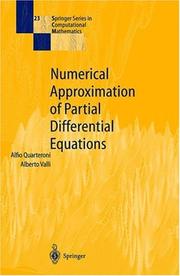
ISBN: 0387571116 3540571116 3540852670 3540852689 9783540571117 Year: 1994 Volume: 23 Publisher: Berlin Springer
Abstract | Keywords | Export | Availability | Bookmark
 Loading...
Loading...Choose an application
- Reference Manager
- EndNote
- RefWorks (Direct export to RefWorks)
Approximation theory --- Differential equations, Partial --- Théorie de l'approximation --- Equations aux dérivées partielles --- Numerical solutions --- Solutions numériques --- -Approximation theory --- 519.6 --- 681.3 *G18 --- Theory of approximation --- Functional analysis --- Functions --- Polynomials --- Chebyshev systems --- Partial differential equations --- Computational mathematics. Numerical analysis. Computer programming --- Partial differential equations: difference methods elliptic equations finite element methods hyperbolic equations method of lines parabolic equations (Numerical analysis) --- Approximation theory. --- Numerical solutions. --- 681.3 *G18 Partial differential equations: difference methods elliptic equations finite element methods hyperbolic equations method of lines parabolic equations (Numerical analysis) --- 519.6 Computational mathematics. Numerical analysis. Computer programming --- Théorie de l'approximation --- Equations aux dérivées partielles --- Solutions numériques --- 681.3 *G18 Partial differential equations: difference methods; elliptic equations; finite element methods; hyperbolic equations; method of lines; parabolic equations (Numerical analysis) --- Partial differential equations: difference methods; elliptic equations; finite element methods; hyperbolic equations; method of lines; parabolic equations (Numerical analysis) --- Numerical solutions of differential equations
Book
ISBN: 2225756708 9782225756702 Year: 1992 Publisher: Paris : Masson,
Abstract | Keywords | Export | Availability | Bookmark
 Loading...
Loading...Choose an application
- Reference Manager
- EndNote
- RefWorks (Direct export to RefWorks)
517.95 --- 519.6 --- 681.3 *G18 --- Partial differential equations --- Computational mathematics. Numerical analysis. Computer programming --- Partial differential equations: difference methods elliptic equations finite element methods hyperbolic equations method of lines parabolic equations (Numerical analysis) --- 681.3 *G18 Partial differential equations: difference methods elliptic equations finite element methods hyperbolic equations method of lines parabolic equations (Numerical analysis) --- 519.6 Computational mathematics. Numerical analysis. Computer programming --- 517.95 Partial differential equations --- 681.3 *G18 Partial differential equations: difference methods; elliptic equations; finite element methods; hyperbolic equations; method of lines; parabolic equations (Numerical analysis) --- Partial differential equations: difference methods; elliptic equations; finite element methods; hyperbolic equations; method of lines; parabolic equations (Numerical analysis) --- Differential equations, Partial --- Numerical solutions. --- Numerical analysis --- Equations aux dérivées partielles --- Analyse numérique --- Equations aux derivees partielles --- Analyse numerique --- Methodes numeriques
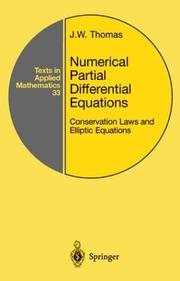
ISBN: 0387983465 0387979999 1461268214 1461205697 1441931058 1489972781 Year: 1999 Volume: 22, 33 Publisher: New York (N.Y.): Springer
Abstract | Keywords | Export | Availability | Bookmark
 Loading...
Loading...Choose an application
- Reference Manager
- EndNote
- RefWorks (Direct export to RefWorks)
Of the many different approaches to solving partial differential equations numerically, this book studies difference methods. Written for the beginning graduate student in applied mathematics and engineering, this text offers a means of coming out of a course with a large number of methods that provide both theoretical knowledge and numerical experience. The reader will learn that numerical experimentation is a part of the subject of numerical solution of partial differential equations, and will be shown some uses and taught some techniques of numerical experimentation.Prerequisites suggested for using this book in a course might include at least one semester of partial differential equations and some programming capability. The author stresses the use of technology throughout the text, allowing the student to utilize it as much as possible. The use of graphics for both illustration and analysis is emphasized, and algebraic manipulators are used when convenient. This is the second volume of a two-part book.
Differential equations, Partial --- -Finite differences --- 519.6 --- 681.3 *G18 --- 681.3 *G18 Partial differential equations: difference methods elliptic equations finite element methods hyperbolic equations method of lines parabolic equations (Numerical analysis) --- Partial differential equations: difference methods elliptic equations finite element methods hyperbolic equations method of lines parabolic equations (Numerical analysis) --- 519.6 Computational mathematics. Numerical analysis. Computer programming --- Computational mathematics. Numerical analysis. Computer programming --- Differences, Finite --- Finite difference method --- Numerical analysis --- Partial differential equations --- Numerical solutions --- Finite differences --- Différences finies --- Différences finies --- 681.3 *G18 Partial differential equations: difference methods; elliptic equations; finite element methods; hyperbolic equations; method of lines; parabolic equations (Numerical analysis) --- Partial differential equations: difference methods; elliptic equations; finite element methods; hyperbolic equations; method of lines; parabolic equations (Numerical analysis) --- Numerical solutions of differential equations --- Finite differences. --- Numerical solutions. --- Equations aux dérivées partielles --- Solutions numériques --- Mathematical analysis. --- Analysis (Mathematics). --- Numerical analysis. --- Analysis. --- Numerical Analysis. --- Mathematical analysis --- 517.1 Mathematical analysis
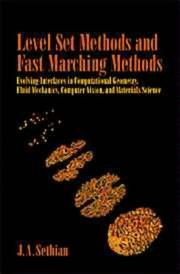
ISBN: 0521645573 0521642043 9780521642040 9780521645577 Year: 1999 Volume: 3 Publisher: Cambridge : Cambridge University Pres,
Abstract | Keywords | Export | Availability | Bookmark
 Loading...
Loading...Choose an application
- Reference Manager
- EndNote
- RefWorks (Direct export to RefWorks)
514.8 --- 681.3*G18 --- 681.3 *G18 Partial differential equations: difference methods elliptic equations finite element methods hyperbolic equations method of lines parabolic equations (Numerical analysis) --- Partial differential equations: difference methods elliptic equations finite element methods hyperbolic equations method of lines parabolic equations (Numerical analysis) --- 514.8 Geometric study of objects of mechanics and physics --- Geometric study of objects of mechanics and physics --- Level set methods --- Level set methods. --- 681.3 *G18 Partial differential equations: difference methods; elliptic equations; finite element methods; hyperbolic equations; method of lines; parabolic equations (Numerical analysis) --- Partial differential equations: difference methods; elliptic equations; finite element methods; hyperbolic equations; method of lines; parabolic equations (Numerical analysis) --- Level sets (Mathematics) --- Osher-Sethian level set methods --- Sethian level set methods, Osher --- -Interfaces (Physical sciences) --- Mathematics --- 681.3 *G18 --- Representation des surfaces
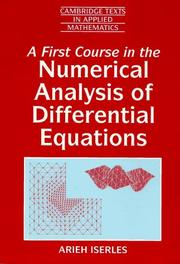
ISBN: 0521556554 0521553768 9780521556552 Year: 1996 Publisher: Cambridge Cambridge University press
Abstract | Keywords | Export | Availability | Bookmark
 Loading...
Loading...Choose an application
- Reference Manager
- EndNote
- RefWorks (Direct export to RefWorks)
Numerical analysis presents different faces to the world. For mathematicians it is a bona fide mathematical theory with an applicable flavour. For scientists and engineers it is a practical, applied subject, part of the standard repertoire of modelling techniques. For computer scientists it is a theory on the interplay of computer architecture and algorithms for real-number calculations. The tension between these standpoints is the driving force of this book, which presents a rigorous account of the fundamentals of numerical analysis of both ordinary and partial differential equations. The point of departure is mathematical but the exposition strives to maintain a balance between theoretical, algorithmic and applied aspects of the subject. In detail, topics covered include numerical solution of ordinary differential equations by multistep and Runge-Kutta methods; finite difference and finite elements techniques for the Poisson equation; a variety of algorithms to solve large, sparse algebraic systems; methods for parabolic and hyperbolic differential equations and techniques of their analysis. The book is accompanied by an appendix that presents brief back-up in a number of mathematical topics. Dr Iserles concentrates on fundamentals: deriving methods from first principles, analysing them with a variety of mathematical techniques and occasionally discussing questions of implementation and applications. By doing so, he is able to lead the reader to theoretical understanding of the subject without neglecting its practical aspects. The outcome is a textbook that is mathematically honest and rigorous and provides its target audience with a wide range of skills in both ordinary and partial differential equations.
differentiaalvergelijking --- wiskunde --- numerieke analyse --- Partial differential equations: difference methods elliptic equations finite element methods hyperbolic equations method of lines parabolic equations (Numerical analysis) --- 681.3 *G18 Partial differential equations: difference methods elliptic equations finite element methods hyperbolic equations method of lines parabolic equations (Numerical analysis) --- Partial differential equations: difference methods; elliptic equations; finite element methods; hyperbolic equations; method of lines; parabolic equations (Numerical analysis) --- 681.3 *G18 Partial differential equations: difference methods; elliptic equations; finite element methods; hyperbolic equations; method of lines; parabolic equations (Numerical analysis) --- Differential equations --- 519.62 --- 681.3 *G18 --- 519.62 Numerical methods for solution of ordinary differential equations --- Numerical methods for solution of ordinary differential equations --- 517.91 Differential equations --- Numerical solutions --- 517.91 --- Numerical solutions. --- Numerical analysis. --- Equations différentielles --- Solutions numériques --- Numerical solutions&delete& --- Differential equations - Numerical solutions. --- Acqui 2006 --- Analyse numerique --- Equations differentielles --- Equations aux derivees partielles
Book
ISBN: 0898712211 9780898712216 Year: 1987 Publisher: Philadelphia (Pa.): Society for industrial and applied mathematics
Abstract | Keywords | Export | Availability | Bookmark
 Loading...
Loading...Choose an application
- Reference Manager
- EndNote
- RefWorks (Direct export to RefWorks)
Multigrid methods (Numerical analysis) --- 519.6 --- 681.3 *G18 --- 681.3*N4 --- 681.3 *G18 Partial differential equations: difference methods elliptic equations finite element methods hyperbolic equations method of lines parabolic equations (Numerical analysis) --- Partial differential equations: difference methods elliptic equations finite element methods hyperbolic equations method of lines parabolic equations (Numerical analysis) --- 519.6 Computational mathematics. Numerical analysis. Computer programming --- Computational mathematics. Numerical analysis. Computer programming --- Computerwetenschap--?*N4 --- Méthodes multigrilles (Analyse numérique) --- Partial differential equations: difference methods; elliptic equations; finite element methods; hyperbolic equations; method of lines; parabolic equations (Numerical analysis) --- Multigrid methods (Numerical analysis). --- 681.3 *G18 Partial differential equations: difference methods; elliptic equations; finite element methods; hyperbolic equations; method of lines; parabolic equations (Numerical analysis) --- Méthodes multigrilles (Analyse numérique) --- Differential equations, Partial --- Numerical solutions. --- Numerical analysis --- Numerical solutions --- Numerical solutions of differential equations --- Boundary value problems --- Problèmes aux limites --- Differential equations, Partial - Numerical solutions
| Listing 1 - 10 of 275 | << page >> |
Sort by
|

 Search
Search Feedback
Feedback About
About Help
Help News
News